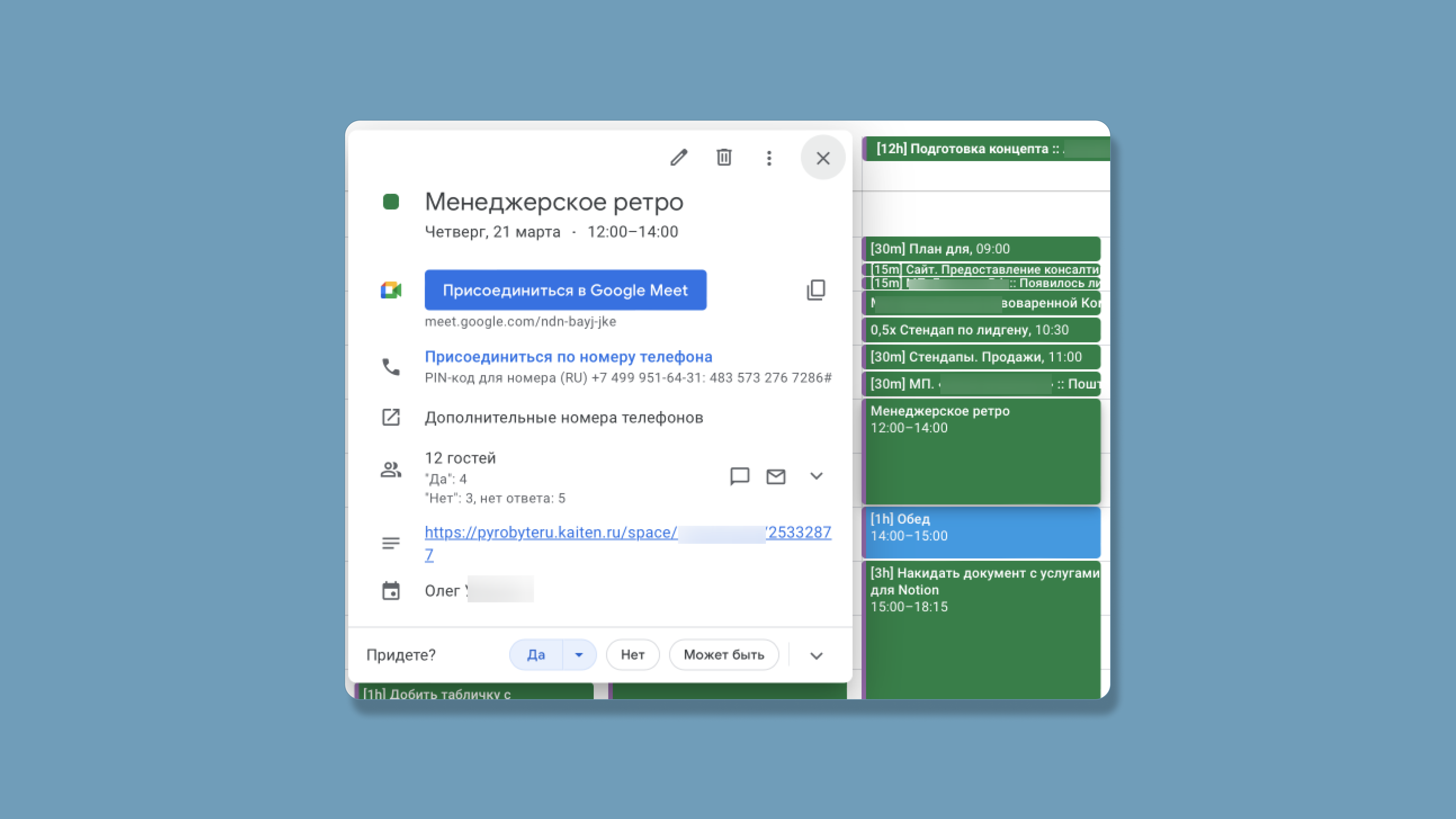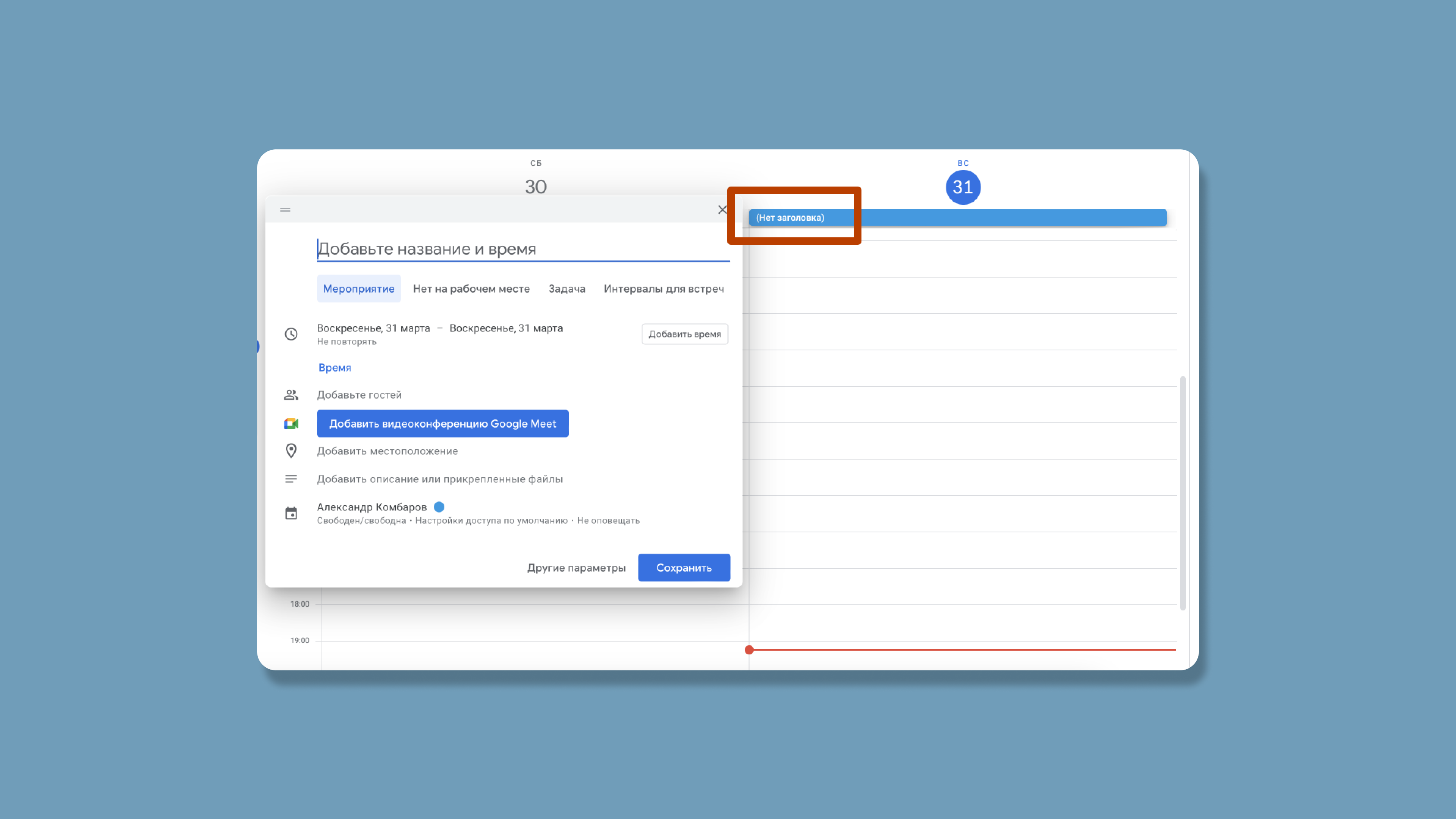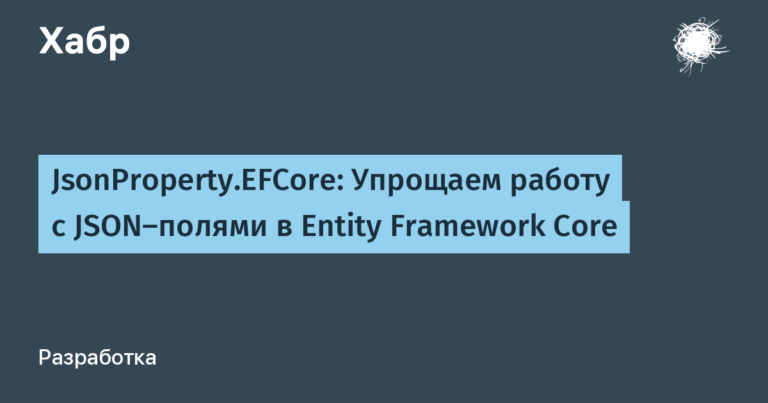daily planning in the calendar. How to plan so as not to experience pain. +Regulations
Hello everyone, my name is Sasha Kombarov, I am the CEO of a web studio. We created bot, which shares regulations that are useful to both the agent and client sides. Today we will talk about daily planning.

The calendar helps you not to miss a call, remember to complete a task, or assign a task to another performer.
Keeping a calendar when working in a team is a must-have. Each participant can place a meeting in a free slot, submit a task with a description, and get acquainted with the tasks you performed. Plan long-term tasks.
In order to ensure that calendar management increases the efficiency of employees and does not cause pain, we have drawn up regulations. The link to it is at the end of the material.
Daily planning
Work hours are planned independently in Google Calendar.
In the morning before the standup, you need to plan tasks for the day on the calendar. Set a regular task for this on your calendar;
Planning should not take more than 10-15 minutes.
Arrange tasks the way you plan to do them. Do it in order (if possible), try not to jump from task to task. With the same priorities, set more complex and voluminous tasks higher – at the end of the day it is morally more difficult to take on complex tasks;
Move those tasks that you don’t plan to do on the current day to the next days. Don't lose them;
Tasks for the day are set in blocks, indicating in square brackets the time the task will take – [1h30m]. To estimate the time needed for a task as accurately as possible, decompose it;

If a task takes more than 10 minutes and requires action rather than answering a question, it should be put on the calendar;
If the task is successfully completed, then it is painted green. If something has been done on a task, but it is not completed, it is painted yellow. If the task was not done, it is painted red and is duplicated temporarily during the next planning.
If a task takes several working days, then you need to break it down into subtasks. For example: you need to create a prototype, it will take 36 hours. Break the task into separate subtasks for each page/block and plan in the calendar with separate tasks: “[2h] Project – Prototype. “Help” page»
It is necessary to plan 7 hours of your working time, as urgent or unplanned tasks may appear – for example, help the team, answer a question, etc.;
Be sure to set the task “Lunch” so that it is clear when you are going to lunch.
A link to the task in Kaiten and links to documents related to the task are added to the task description to make it easier and faster for you or the performer to solve it. Or the manager can understand the essence of the task;

Plan all checkpoints, reminders, emails in the calendar for future days – you shouldn’t rely on memory, and a lost task can be expensive. Just write down tasks with instructions, add materials, without planning at what time of the day you will perform the task – you will do this in daily planning;
If a task took longer than planned, leave in brackets the time you planned for it and stretch it out on the calendar to show how much time it actually took you. This way you will see where you made a mistake in your assessment, and you will be able to estimate the task more accurately next time;
Tasks for one project should be grouped so that there is no frequent switching to different projects – because of this, the brain takes longer and more difficult to think;
If the task concerns a specific project, the name of this project is written after the time;

Types of tasks to put on your calendar
Major tasks are to conduct testing, draw up estimates and proposals, write an article.
Medium tasks are to conduct a stand-up with the team, process new tasks from the client and transfer them to the board.
Small tasks – answer the letter (if you don’t do it right away and quickly), check whether the payment has arrived.
Regular tasks throughout the day – for example, calling a client several times who takes a long time to answer to find out details about the task – put them at the top of the calendar. There is no need to indicate the time, because you will return to this task several times, and it is unclear how long it will take you.

General tasks and assignment of tasks to performers
If the task is general (requires the participation of several people), then add everyone else to the task via corporate email. You can find the addresses of all performers in this table. After that, everyone’s task will be duplicated in their calendars at the same time. When editing the main task, it will also be updated for the others.
If you need to assign a task to another performer, then select him from the list.
In the task of another performer, we write the time to complete this task in the same way. If you don’t know how much it will take, get an estimate from the contractor.
We also include a link to Kaiten with the task statement in the task.
We assign tasks to other performers for at least the next day. We don’t cast on the current one. Learn to plan the necessary resources in advance.
Possible reasons for frequent failure to fulfill the plan
Unrealistic estimates. It is important to analyze which tasks took more time than planned. Remember why they took longer, what problem arose, what was not taken into account. Is it a systemic problem? Is it possible to do something about this? Very large tasks (more than 4 hours) need to be decomposed. It is necessary to evaluate objectively based on your capabilities. Some quickly add things up in their heads, some write, and some analyze large amounts of data. Not everyone can write a technical specification on 20 pages in a day. But if the assessments of two competent specialists differ by 2-3 or more times, then it is necessary to analyze the formulation and process of performing the future task – probably the specialists have a different understanding of the task;
Frequent switching. It has long been proven that switching to another task even for 1 minute or simply responding in messenger takes at least 10-15 minutes of productive time. The Pomodoro method and its derivatives help a lot. You can check your email or instant messengers between tasks, and turn on the Do Not Disturb mode during the work cycle when completing a task. Those who really need it will do. All other things being equal, it is better to complete one task entirely than to receive two half-completed ones the next day. The Pareto principle does not apply here;
Unplanned tasks. It is important to understand that most of the tasks that arrive during the day are lower priority than completing the daily plan. Is the new task urgent and important to do today (see Eisenhower Matrix)? Can it be delegated? If a task cannot be postponed until tomorrow, then it is quite likely that you can switch to it between other tasks either in the evening, and not right now;
Overwork. Trying to do everything at once often leads to general fatigue and low efficiency. Symptoms may be: unconscious switching, poor concentration, difficulty entering the subject area. The reason may be: frequent delays in the evenings, lack of rest during the day, constant extremely high workload.
We remember that an unfulfilled plan has a negative impact on self-esteem and the impression of the work done during the day. In addition, unfulfilled tasks tend to accumulate like an avalanche.
Useful literature on planning:
“How to put things in order. The Art of Stress-Free Productivity by David Allen.
“Tight time management. Take control of your life by Dan Kennedy.
“Maximum concentration. How to Stay Effective in the Age of Clip Thinking by Lucy Jo Palladino.
This and other regulations are already available in Telegram bot. Write to him and he will send you the documents!




